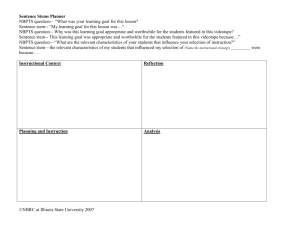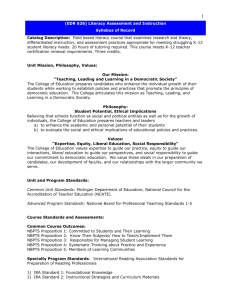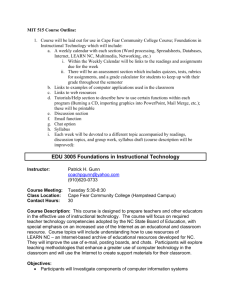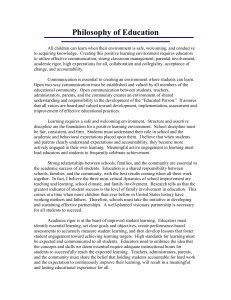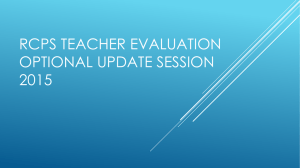Multicultural Education in an Urban Context (3
advertisement
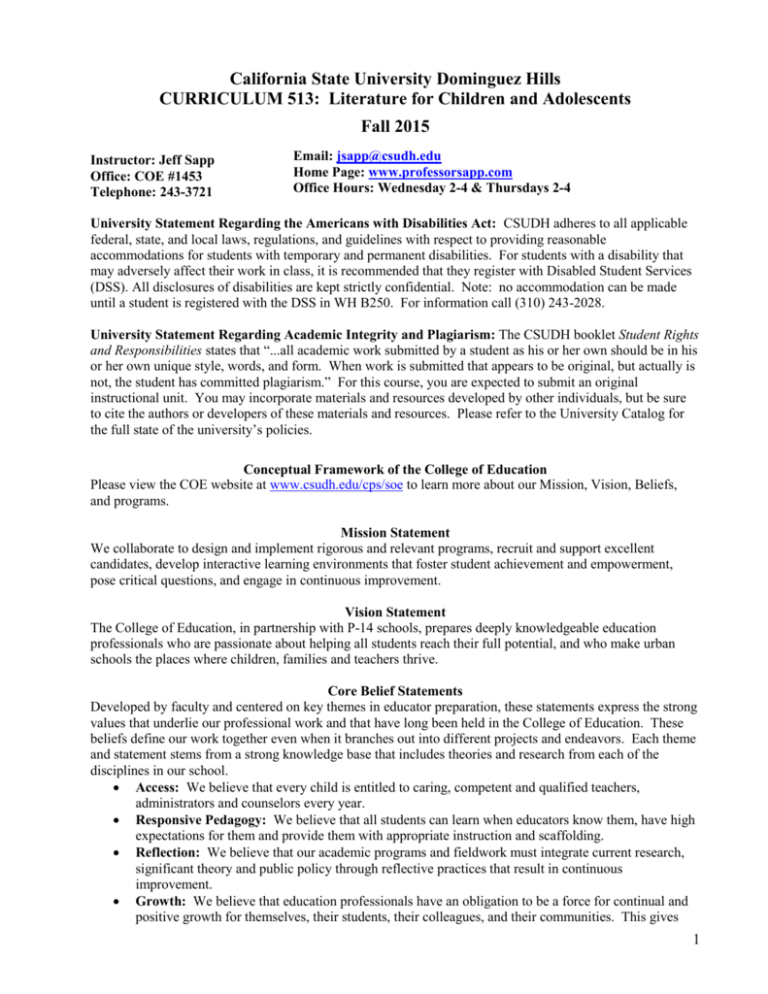
California State University Dominguez Hills CURRICULUM 513: Literature for Children and Adolescents Fall 2015 Instructor: Jeff Sapp Office: COE #1453 Telephone: 243-3721 Email: jsapp@csudh.edu Home Page: www.professorsapp.com Office Hours: Wednesday 2-4 & Thursdays 2-4 University Statement Regarding the Americans with Disabilities Act: CSUDH adheres to all applicable federal, state, and local laws, regulations, and guidelines with respect to providing reasonable accommodations for students with temporary and permanent disabilities. For students with a disability that may adversely affect their work in class, it is recommended that they register with Disabled Student Services (DSS). All disclosures of disabilities are kept strictly confidential. Note: no accommodation can be made until a student is registered with the DSS in WH B250. For information call (310) 243-2028. University Statement Regarding Academic Integrity and Plagiarism: The CSUDH booklet Student Rights and Responsibilities states that “...all academic work submitted by a student as his or her own should be in his or her own unique style, words, and form. When work is submitted that appears to be original, but actually is not, the student has committed plagiarism.” For this course, you are expected to submit an original instructional unit. You may incorporate materials and resources developed by other individuals, but be sure to cite the authors or developers of these materials and resources. Please refer to the University Catalog for the full state of the university’s policies. Conceptual Framework of the College of Education Please view the COE website at www.csudh.edu/cps/soe to learn more about our Mission, Vision, Beliefs, and programs. Mission Statement We collaborate to design and implement rigorous and relevant programs, recruit and support excellent candidates, develop interactive learning environments that foster student achievement and empowerment, pose critical questions, and engage in continuous improvement. Vision Statement The College of Education, in partnership with P-14 schools, prepares deeply knowledgeable education professionals who are passionate about helping all students reach their full potential, and who make urban schools the places where children, families and teachers thrive. Core Belief Statements Developed by faculty and centered on key themes in educator preparation, these statements express the strong values that underlie our professional work and that have long been held in the College of Education. These beliefs define our work together even when it branches out into different projects and endeavors. Each theme and statement stems from a strong knowledge base that includes theories and research from each of the disciplines in our school. Access: We believe that every child is entitled to caring, competent and qualified teachers, administrators and counselors every year. Responsive Pedagogy: We believe that all students can learn when educators know them, have high expectations for them and provide them with appropriate instruction and scaffolding. Reflection: We believe that our academic programs and fieldwork must integrate current research, significant theory and public policy through reflective practices that result in continuous improvement. Growth: We believe that education professionals have an obligation to be a force for continual and positive growth for themselves, their students, their colleagues, and their communities. This gives 1 purpose to our practice of continuous assessment and improvement. Collaboration: We believe that collaboration within and among all stakeholders and communities is integral to learning and to transforming schools. Curriculum & Instruction Operational Dispositions The educator will: 1. Understand the philosophical foundations of learning and development. 2. Understand and incorporate research and theory in learning and development. 3. Meet the educational needs of urban and diverse populations. 4. Demonstrate skills necessary to perform as an effective educator. 5. Be able to organize and manage an educational setting. 6. Be effective at promoting student learning. 7. Utilize technology effectively. 8. Be effective at promoting student learning. 9. Meet the standards of the profession. 10. Assume a leadership role in developing and implementing learning and development. 11. Be confident, responsive, and supportive in interactions with parents. Computer/Information Literacy Expectations for Students enrolled in this class Students in this class are expected to: 1) use the university email system (Toromail), 2) use a word processing program for writing assignments (e.g., Microsoft Word), 3) be able to access assigned websites through the internet, 4) use the Library databases to find peer-reviewed journal literature, 5) be able to create a power point presentation, and 6) be able to paraphrase concepts without plagiarizing. For additional information about computing on campus, including tutorials, students should go to: http://www.csudh.edu/infotech/labs http://www.csudh.edu/infotech/student_index.shtml 2 National Board for Professional Teaching Standards (NBPTS) These Five Core Propositions from NBPTS form the foundation and frame the rich amalgam of knowledge, skills, dispositions and beliefs that characterize excellence in National Board Certified Teachers. CSUDH is committed to these Propositions and they guide the instruction in C&I. Proposition 1: Educators are Committed to Students and Their Learning A. Educators are dedicated to making knowledge accessible to all students. They believe all students can learn. B. They treat students equitably. They recognize the individual differences that distinguish their students from one another and they take account for these differences in their practice. C. Educators understand how students develop and learn. D. They respect the cultural and family differences students bring to their classroom. E. They are concerned with their students’ self-concept, their motivation and the effects of learning on peer relationships. F. Educators are also concerned with the development of character and civic responsibility. Proposition 2: Educators Know the Subjects They Teach and How to Teach Those Subjects to Students A. Educators have mastery over the subject(s) they teach. They have a deep understanding of the history, structure and real-world applications of the subject. B. They have skill and experience in teaching it, and they are very familiar with the skills gaps and preconceptions students may bring to the subject. C. They are able to use diverse instructional strategies to teach for understanding. Proposition 3: Educators are Responsible for Managing and Monitoring Student Learning A. Educators deliver effective instruction. They move fluently through a range of instructional techniques, keeping students motivated, engaged and focused. B. They know how to engage students to ensure a disciplined learning environment, and how to organize instruction to meet instructional goals. C. Educators know how to assess the progress of individual students as well as the class as a whole. D. They use multiple methods for measuring student growth and understanding, and they can clearly explain student performance to parents. Proposition 4: Educators Think Systematically about Their Practice and Learn from Experience A. Educators model what it means to be an educated person – they read, they question, they create and they are willing to try new things. B. They are familiar with learning theories and instructional strategies and stay abreast of current issues in American education. C. They critically examine their practice on a regular basis to deepen knowledge, expand their repertoire of skills, and incorporate new findings into their practice. Proposition 5: Educators are Members of Learning Communities A. Educators collaborate with others to improve student learning. B. They are leaders and actively know how to seek and build partnerships with community groups and businesses. C. They work with other professionals on instructional policy, curriculum development and staff development. D. They can evaluate school progress and the allocation of resources in order to meet state and local education objectives. E. They know how to work collaboratively with parents to engage them productively in the work of the school. 3 Course Description: This course in children’s literature provides an opportunity to read extensively in the genres of literature suitable for children, in order to become informed about their range and literary features. Through development of critical skills in evaluating literature we become effective parents, teachers and citizens responsible for the interaction of children and literature in today’s culture with its competing appeals for children’s time and attention. This is a graduate level course exploring literature for children and related issues: who writes it, who publishes it, who judges it, who reads it, who censors it, who benefits from it? This course satisfies the requirement for the masters program in curriculum. Course Outcomes: Upon successful completion of this course, students will be able: 1. To experience children’s literature: to re-discover the sheer pleasure of literature for children, in part through recalling your own reading experience, and to become prepared to share that pleasure with the next generation of readers. (CSTP Standard 1: Program Design, Rationale, and Coordination. CSTP Standard 2: Creating and maintaining effective environments for student learning. NBPTS # 2: Teachers know the subjects they teach and how to teach those subjects to students.) 2. To develop critical skills for evaluating and appreciating literature in its several functions—aesthetic, information, liberation, values development, cultural transmission, language formation—and as a rhetorical medium of written and visual communication. (CSTP Standard 2: Creating and maintaining effective environments for student learning. CSTP Standard 1.C. Facilitate a learning experience that promotes autonomy, interaction, and choice. CSTP Standard 1D: Engaging students in problem solving, critical thinking and other activities that make subject matter meaningful. NBPTS # 2: Teachers know the subjects they teach and how to teach those subjects to students.) 3. To develop a repertoire of literature from various genres to draw upon in settings where reading is called for to benefit child development. (CSTP Standard 1A. Connect students’ prior knowledge, life experiences, and interests with learning goals. CCTC Standard 3.2: Analyze texts in different literary genres according to their structure, organization, and purpose. NBPTS # 2: Teachers know the subjects they teach and how to teach those subjects to students). 4. To improve skills in reporting on research, in-group discussion, in writing responses and critical analyses, in thinking critically about literature, and in oral presentation of author reports and individual literary works, including poetry. (CSTP Standard 1D: Engaging students in problem solving, critical thinking and other activities that make subject matter meaningful. NBPTS #4: Teachers think systematically about their practice and learn from experience). 5. To gain knowledge of reference resources useful for locating and assessing literature. (CSTP 3E: Using materials, resources, and technologies to make subject matter accessible to students. NBPTS #5: Teachers are members of the learning communities). Standards Key: CSTP: California Standards for the Teaching Profession, CCTC: California Commission on Teacher Credentialing, NBPTS: National Board for Professional Teaching Standards. Required Texts: Temple, Martinez, & Yokota. Children’s books in children’s hands (Fourth Edition) Allyn and Bacon, Inc.: Boston, MA. 2011. 4 Requirements: 1. Class attendance is important! “In a given community of listeners, the absence of any member diminishes the story. In a story-telling course, for instance, the listener is so integral that any student who misses class should account for it, not because of a grade but because of its effect on the community.” (Betsy Hearn, Horn Book, January/February, 2005). 2. Be prepared to discuss any reading assignments. 3. Students will sign up for group presentations of one chapter in the text. Each presenting member will read aloud or give oral summary of books recommended in the chapter (20 points). (This assignment supports NBPTS #2 to assist teachers acquire the knowledge about available selections in children’s literature so that they can pass this information on to their students.) 4. Students will submit 10 comprehension questions directly related to Caldecott award winning books (10 points). (This assignment supports NBPTS standards #1, #2 & #5 by creating opportunities for professionals to practice developing tools to make knowledge accessible for all students.) 5. Students will read a Newbery award-winning book in a book club setting (10 points). (This assignment also supports NBPTS #4 by providing them with experiences in selecting appropriate choices of children’s literature for their students and practice presentation skills). 6. Students will select and read an adolescent novel based on 4 adolescent issue topics that are generated in our class as a way to build a classroom library set of adolescent novels of interest to young people (10 points). Students will submit an annotated bibliography of their novel choice. (This assignment supports NBPTS standard #1 by demonstrating an ethical awareness of students’ lives.) 7. Students will do an extension menu project (30 points). (This assignment supports NBPTS standards #2 & #5 by developing curriculum connections and specialized information to support the learning community.) 8. Students will write/create their own ABC Book that introduces content area vocabulary to the students they are teaching (20 points). (This assignment supports NBPTS standards #1, #2 & #5 by creating opportunities for professionals to practice developing tools to make knowledge accessible for all students.) Course Requirements Group Presentation Newbery Book Club Caldecott Comprehension Questions Annotated Bibliography of an YA Novel ABC Book Extension Menu Project Points 20 points 10 points 10 points 10 points 20 points 30 points Due Date On-Going On-Going September 17th October 22nd October 29th December 3rd 5 Extension Menu for CURRICULUM 513 Projects (30 points) 1. AUTHOR STUDY If you’re teaching or focusing on a specific author, this is a great way to collect information on that chosen author. 4. CREATE A READERS’ THEATER A great choice for middle and high school teachers who want to add some drama (literally!) to their classrooms. 7. DEVELOP A CURRICULUM UNIT No matter what you teach, think of approaching specific content through multiple genres of literature. 2. WRITE A BOOK This is CUR 513’s most chosen Menu Project! Wow! 3. DEVELOP A FILE Whether it is an annotated bibliography of picture books on a quilt theme or a collection of YA novels that deal with bullying, this menu project lets you build a usable resource for your classroom. 5. WRITE YOUR OWN IDEA & SUBMIT FOR APPROVAL 6. CREATE & PRESENT A PUPPET SHOW Yeah, so surprise me! This could be an ‘ol traditional puppet show or a new technology-based puppet show. 8. MUSICAL PRESENTATION BASED ON A CHILDREN’S BOOK I know some of you have some mad music skills, so why not put them to use with an original piece? 9. ILLUSTRATOR STUDY Biographical sketch, book list, artist’s style, summary of books read, curriculum connections, book activities – use this menu project to look at the artist behind the story. Please see examples online at www.professorsapp.com 6 Course Schedule for CUR 513 Fall 2015 with Dr. Jeff Sapp Session Topic Aug 27 Course Introduction Memorable Literature Overview of Course Sept 3 Children’s Books in Children’s Hands Online History of Children’s Literature Sept 10 Literary Elements in Works for Children Genre Matrix Sept 17 Picture Books Shared Reading ABC Books Semantic Maps Author Profiles Sept 24 Literature Representing Diverse Perspectives Oct 1 No Class – Online Assignment Oct 8 Presentation on International Literature Presentation on Poetry Oct 15 Presentation on Traditional Literature Presentation on Modern Fantasy Novel Matrix using Modern Fantasy Novel Oct 22 Presentation on Science Fiction Presentation on Information Books Oct 29 Presentation on Contemporary Realistic Fiction Presentation on Historical Fiction Nov 5 No Class – Online Assignment Nov 12 Presentation on Biography Literature Circles – Paired Sharing Nov 19 Literature Circles – Leadership Literature Circles – Point-of-View Nov 26 No Class – Fall Break Dec 3 What have we learned? Assignment Have chapter 1 read Have chapter 2 read Read Wildcat Goes A’Bragging: An Appalachian Tale DUE: Caldecott Comprehension Questions Read Rhinos & Raspberries: Tolerance Tales for the Early Grades Read Australasian Journal of Early Childhood article Read Teaching As A Subversive Act DUE: Proposal for Extension Menu Project DUE: Annotated Bibliography of a YA Novel DUE: ABC Book DUE: Extension Menu Project 7
